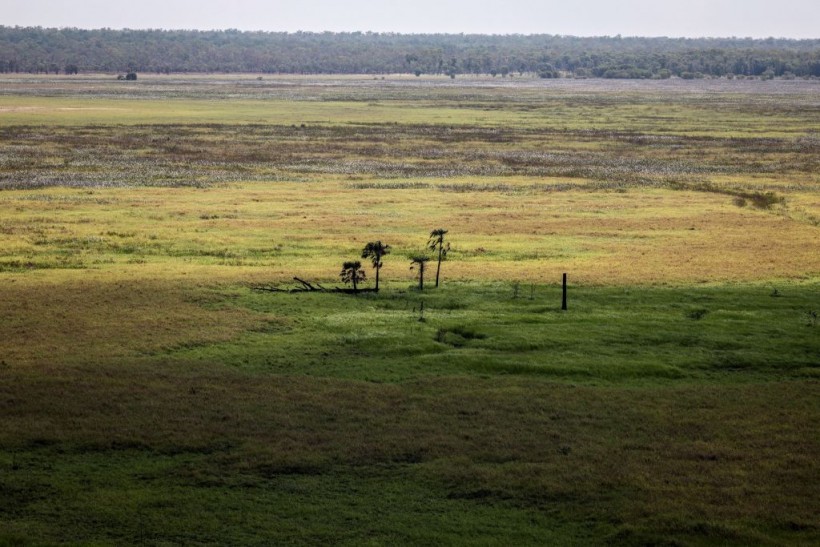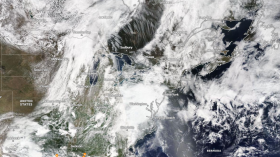Savannas and grasslands are among the most widespread ecosystems on Earth, covering about 40% of the global land surface.
They are home to a rich diversity of plants and animals and provide vital ecosystem services such as food production, water regulation, and carbon sequestration.
However, these ecosystems are also highly vulnerable to climate change and human activities, especially changes in fire regimes.
Fire is a natural and essential component of savanna and grassland dynamics, shaping their structure, composition, and function.
However, fire frequency and intensity have been altered by human activities such as land use change, fire suppression, and fire ignition.
These changes have profound implications for the amount of carbon stored in the soil, which is the largest terrestrial carbon pool and a key factor in regulating the global climate.
How fire affects soil carbon storage in savannas and grasslands
 (Photo : DAVID GRAY/AFP via Getty Images)
(Photo : DAVID GRAY/AFP via Getty Images)

Soil carbon storage is influenced by many factors, such as climate, vegetation, soil type, and disturbance.
Fire can affect soil carbon storage in different ways, depending on the fire regime (the frequency, intensity, seasonality, and spatial pattern of fires) and the ecosystem characteristics.
In general, fire can reduce soil carbon storage by directly combusting organic matter, increasing soil temperature and decomposition rates, altering soil microbial communities and nutrient cycling, and changing plant productivity and litter quality.
However, fire can also increase soil carbon storage by stimulating plant growth and root biomass, enhancing soil aggregation and stability, reducing soil erosion, and facilitating the accumulation of charcoal.
The net effect of fire on soil carbon storage depends on the balance between these positive and negative feedbacks, which can vary across different savanna and grassland types.
For example, in humid savannas and grasslands, where water availability is high and plant productivity is limited by nutrients, fire can stimulate plant growth and increase soil carbon inputs.
In contrast, in arid and semi-arid savannas and grasslands, where water availability is low and plant productivity is limited by water stress, fire can reduce plant growth and decrease soil carbon inputs.
Also Read: Moisture Is an Important Regulator and Sequestrant of Soil Carbon Stocks [STUDY]
A global synthesis of fire effects on soil carbon storage
To better understand how fire affects soil carbon storage across different savanna and grassland types, a team of researchers from around the world conducted a global synthesis of data from 53 long-term fire-manipulation experiments.
They also collected new field data from six of these sites to measure soil carbon stocks and fractions.
The researchers found that within savanna-grassland regions, drier ecosystems were more vulnerable to changes in fire frequency than humid ecosystems.
Specifically, they found that reducing fire frequency increased soil carbon storage by 23% in arid and semi-arid savannas and grasslands, but had no significant effect in humid savannas and grasslands.
Conversely, increasing fire frequency decreased soil carbon storage by 11% in arid and semi-arid savannas and grasslands, but had no significant effect in humid savannas and grasslands.
The researchers also found that most of the state-of-the-art ecosystem models used by climate researchers underestimated the effects of fire on soil carbon storage in drier savannas and grasslands.
This suggests that these models need to be improved to better represent the interactions between fire, vegetation, and soil processes in these ecosystems.
Implications for climate change mitigation
The findings of this study have important implications for climate change mitigation strategies that aim to enhance soil carbon sequestration in savannas and grasslands.
According to the study, reducing fire frequency in drier savannas and grasslands could be an effective way to increase soil carbon storage and slow down the rate of climate warming.
However, this strategy should also consider the potential trade-offs with other ecosystem services and biodiversity conservation goals.
The study also highlighted the need for more research to understand the mechanisms underlying the effects of fire on soil carbon storage in different savanna and grassland types.
This could help to develop more accurate models and projections of future changes in these ecosystems under different scenarios of climate change and human activities.
Related article: Fungi and Their 'Necromass': A Surprising Source of Soil Carbon Sequestration
© 2024 NatureWorldNews.com All rights reserved. Do not reproduce without permission.



![Venomous Centipede Could be Game-Changer and Save Lives of People with Kidney Disease [Study]](https://1471793142.rsc.cdn77.org/data/thumbs/full/70407/280/157/50/40/venomous-centipede-could-be-game-changer-and-save-lives-of-people-with-kidney-disease-study.jpg)

